Performance Comparison: Remote Access and Direct Access Strategies
VerifiedAdded on 2023/06/14
|10
|2689
|438
Essay
AI Summary
This essay provides a detailed comparison of remote access and direct access strategies for establishing remote connections within an organization. It explores the functionality of each strategy, highlighting the pros and cons of using VPN-based remote access versus the newer direct access technology introduced with Windows Server 2008R2. The essay discusses the security aspects, cost implications, and response times associated with both approaches, ultimately concluding that while direct access offers quicker response times due to its automated connection establishment, the choice between the two depends largely on the specific requirements and infrastructure of the organization. The document is available on Desklib, a platform offering a range of study tools and resources for students.

Running head: SERVER ADMINISTRATION
Server Administration
Name of the Student
Name of the University
Author Note
Server Administration
Name of the Student
Name of the University
Author Note
Paraphrase This Document
Need a fresh take? Get an instant paraphrase of this document with our AI Paraphraser
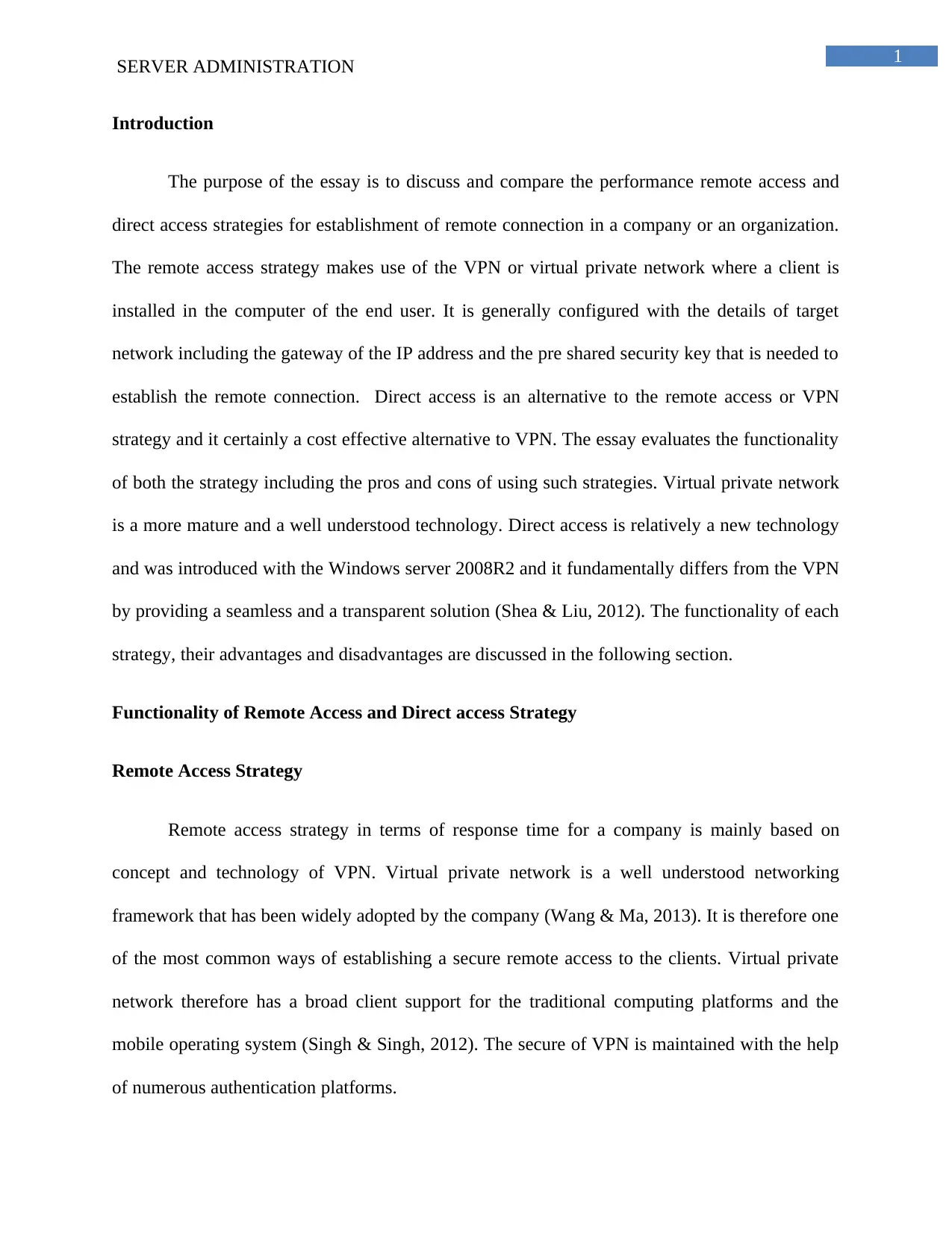
1
SERVER ADMINISTRATION
Introduction
The purpose of the essay is to discuss and compare the performance remote access and
direct access strategies for establishment of remote connection in a company or an organization.
The remote access strategy makes use of the VPN or virtual private network where a client is
installed in the computer of the end user. It is generally configured with the details of target
network including the gateway of the IP address and the pre shared security key that is needed to
establish the remote connection. Direct access is an alternative to the remote access or VPN
strategy and it certainly a cost effective alternative to VPN. The essay evaluates the functionality
of both the strategy including the pros and cons of using such strategies. Virtual private network
is a more mature and a well understood technology. Direct access is relatively a new technology
and was introduced with the Windows server 2008R2 and it fundamentally differs from the VPN
by providing a seamless and a transparent solution (Shea & Liu, 2012). The functionality of each
strategy, their advantages and disadvantages are discussed in the following section.
Functionality of Remote Access and Direct access Strategy
Remote Access Strategy
Remote access strategy in terms of response time for a company is mainly based on
concept and technology of VPN. Virtual private network is a well understood networking
framework that has been widely adopted by the company (Wang & Ma, 2013). It is therefore one
of the most common ways of establishing a secure remote access to the clients. Virtual private
network therefore has a broad client support for the traditional computing platforms and the
mobile operating system (Singh & Singh, 2012). The secure of VPN is maintained with the help
of numerous authentication platforms.
SERVER ADMINISTRATION
Introduction
The purpose of the essay is to discuss and compare the performance remote access and
direct access strategies for establishment of remote connection in a company or an organization.
The remote access strategy makes use of the VPN or virtual private network where a client is
installed in the computer of the end user. It is generally configured with the details of target
network including the gateway of the IP address and the pre shared security key that is needed to
establish the remote connection. Direct access is an alternative to the remote access or VPN
strategy and it certainly a cost effective alternative to VPN. The essay evaluates the functionality
of both the strategy including the pros and cons of using such strategies. Virtual private network
is a more mature and a well understood technology. Direct access is relatively a new technology
and was introduced with the Windows server 2008R2 and it fundamentally differs from the VPN
by providing a seamless and a transparent solution (Shea & Liu, 2012). The functionality of each
strategy, their advantages and disadvantages are discussed in the following section.
Functionality of Remote Access and Direct access Strategy
Remote Access Strategy
Remote access strategy in terms of response time for a company is mainly based on
concept and technology of VPN. Virtual private network is a well understood networking
framework that has been widely adopted by the company (Wang & Ma, 2013). It is therefore one
of the most common ways of establishing a secure remote access to the clients. Virtual private
network therefore has a broad client support for the traditional computing platforms and the
mobile operating system (Singh & Singh, 2012). The secure of VPN is maintained with the help
of numerous authentication platforms.
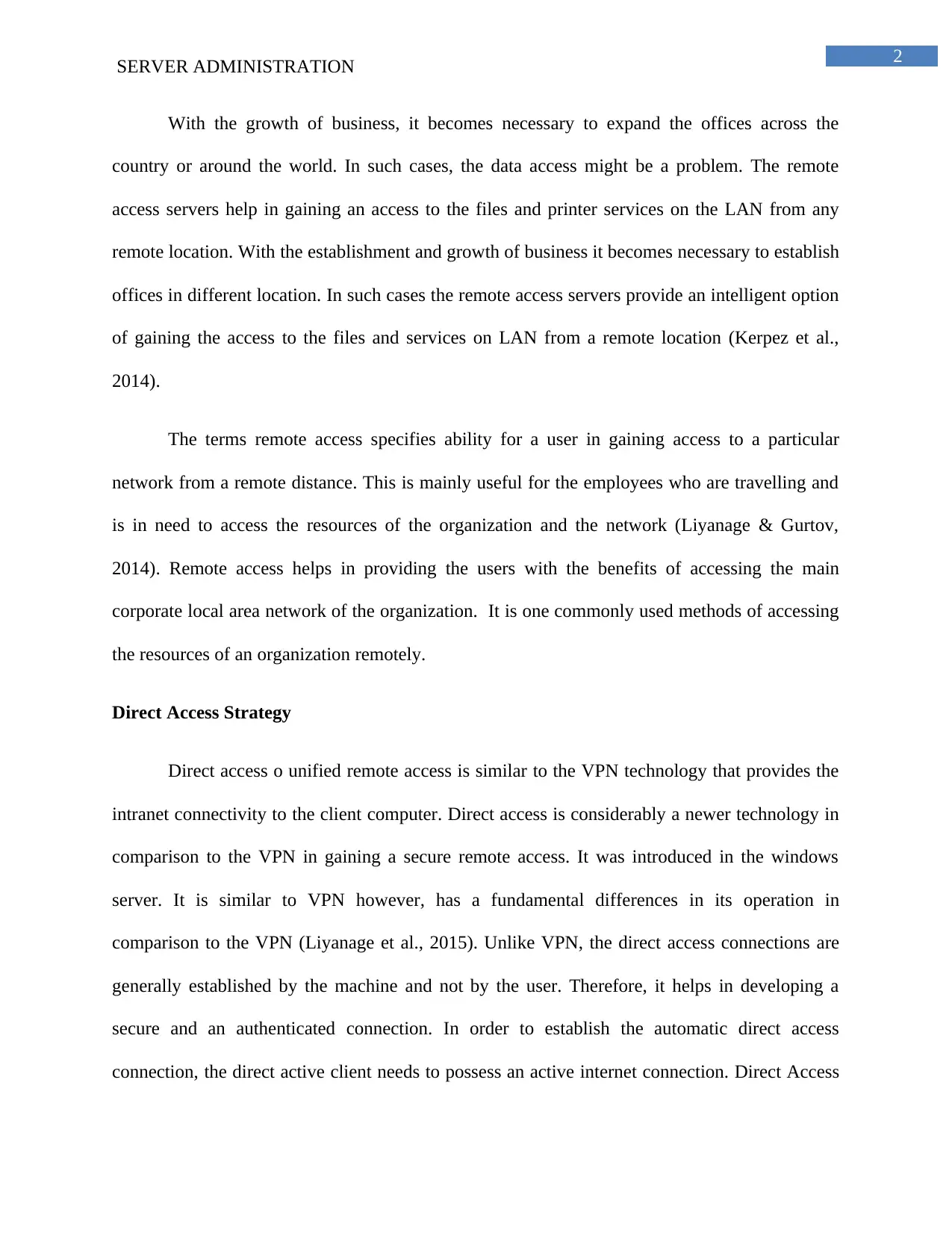
2
SERVER ADMINISTRATION
With the growth of business, it becomes necessary to expand the offices across the
country or around the world. In such cases, the data access might be a problem. The remote
access servers help in gaining an access to the files and printer services on the LAN from any
remote location. With the establishment and growth of business it becomes necessary to establish
offices in different location. In such cases the remote access servers provide an intelligent option
of gaining the access to the files and services on LAN from a remote location (Kerpez et al.,
2014).
The terms remote access specifies ability for a user in gaining access to a particular
network from a remote distance. This is mainly useful for the employees who are travelling and
is in need to access the resources of the organization and the network (Liyanage & Gurtov,
2014). Remote access helps in providing the users with the benefits of accessing the main
corporate local area network of the organization. It is one commonly used methods of accessing
the resources of an organization remotely.
Direct Access Strategy
Direct access o unified remote access is similar to the VPN technology that provides the
intranet connectivity to the client computer. Direct access is considerably a newer technology in
comparison to the VPN in gaining a secure remote access. It was introduced in the windows
server. It is similar to VPN however, has a fundamental differences in its operation in
comparison to the VPN (Liyanage et al., 2015). Unlike VPN, the direct access connections are
generally established by the machine and not by the user. Therefore, it helps in developing a
secure and an authenticated connection. In order to establish the automatic direct access
connection, the direct active client needs to possess an active internet connection. Direct Access
SERVER ADMINISTRATION
With the growth of business, it becomes necessary to expand the offices across the
country or around the world. In such cases, the data access might be a problem. The remote
access servers help in gaining an access to the files and printer services on the LAN from any
remote location. With the establishment and growth of business it becomes necessary to establish
offices in different location. In such cases the remote access servers provide an intelligent option
of gaining the access to the files and services on LAN from a remote location (Kerpez et al.,
2014).
The terms remote access specifies ability for a user in gaining access to a particular
network from a remote distance. This is mainly useful for the employees who are travelling and
is in need to access the resources of the organization and the network (Liyanage & Gurtov,
2014). Remote access helps in providing the users with the benefits of accessing the main
corporate local area network of the organization. It is one commonly used methods of accessing
the resources of an organization remotely.
Direct Access Strategy
Direct access o unified remote access is similar to the VPN technology that provides the
intranet connectivity to the client computer. Direct access is considerably a newer technology in
comparison to the VPN in gaining a secure remote access. It was introduced in the windows
server. It is similar to VPN however, has a fundamental differences in its operation in
comparison to the VPN (Liyanage et al., 2015). Unlike VPN, the direct access connections are
generally established by the machine and not by the user. Therefore, it helps in developing a
secure and an authenticated connection. In order to establish the automatic direct access
connection, the direct active client needs to possess an active internet connection. Direct Access
⊘ This is a preview!⊘
Do you want full access?
Subscribe today to unlock all pages.

Trusted by 1+ million students worldwide
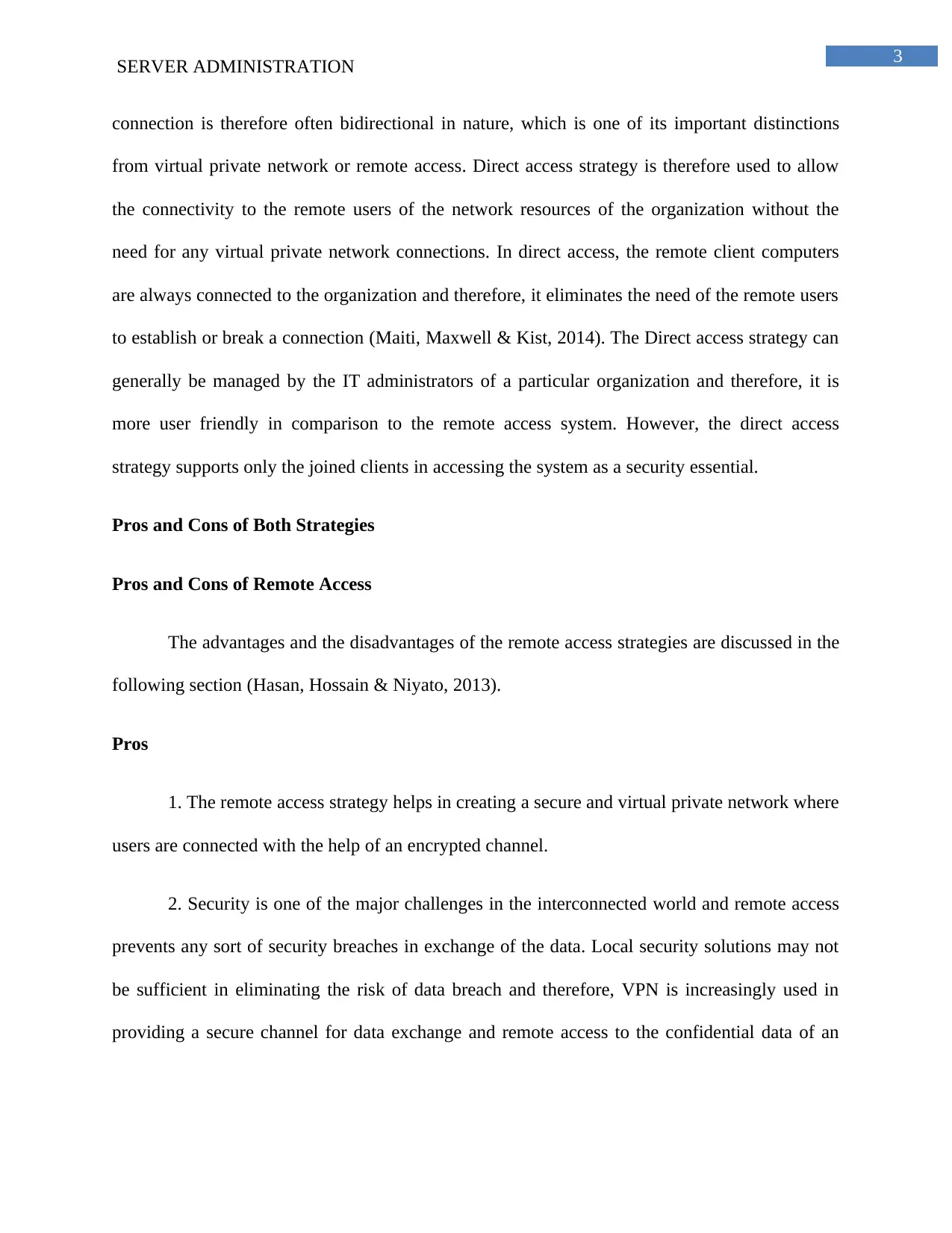
3
SERVER ADMINISTRATION
connection is therefore often bidirectional in nature, which is one of its important distinctions
from virtual private network or remote access. Direct access strategy is therefore used to allow
the connectivity to the remote users of the network resources of the organization without the
need for any virtual private network connections. In direct access, the remote client computers
are always connected to the organization and therefore, it eliminates the need of the remote users
to establish or break a connection (Maiti, Maxwell & Kist, 2014). The Direct access strategy can
generally be managed by the IT administrators of a particular organization and therefore, it is
more user friendly in comparison to the remote access system. However, the direct access
strategy supports only the joined clients in accessing the system as a security essential.
Pros and Cons of Both Strategies
Pros and Cons of Remote Access
The advantages and the disadvantages of the remote access strategies are discussed in the
following section (Hasan, Hossain & Niyato, 2013).
Pros
1. The remote access strategy helps in creating a secure and virtual private network where
users are connected with the help of an encrypted channel.
2. Security is one of the major challenges in the interconnected world and remote access
prevents any sort of security breaches in exchange of the data. Local security solutions may not
be sufficient in eliminating the risk of data breach and therefore, VPN is increasingly used in
providing a secure channel for data exchange and remote access to the confidential data of an
SERVER ADMINISTRATION
connection is therefore often bidirectional in nature, which is one of its important distinctions
from virtual private network or remote access. Direct access strategy is therefore used to allow
the connectivity to the remote users of the network resources of the organization without the
need for any virtual private network connections. In direct access, the remote client computers
are always connected to the organization and therefore, it eliminates the need of the remote users
to establish or break a connection (Maiti, Maxwell & Kist, 2014). The Direct access strategy can
generally be managed by the IT administrators of a particular organization and therefore, it is
more user friendly in comparison to the remote access system. However, the direct access
strategy supports only the joined clients in accessing the system as a security essential.
Pros and Cons of Both Strategies
Pros and Cons of Remote Access
The advantages and the disadvantages of the remote access strategies are discussed in the
following section (Hasan, Hossain & Niyato, 2013).
Pros
1. The remote access strategy helps in creating a secure and virtual private network where
users are connected with the help of an encrypted channel.
2. Security is one of the major challenges in the interconnected world and remote access
prevents any sort of security breaches in exchange of the data. Local security solutions may not
be sufficient in eliminating the risk of data breach and therefore, VPN is increasingly used in
providing a secure channel for data exchange and remote access to the confidential data of an
Paraphrase This Document
Need a fresh take? Get an instant paraphrase of this document with our AI Paraphraser
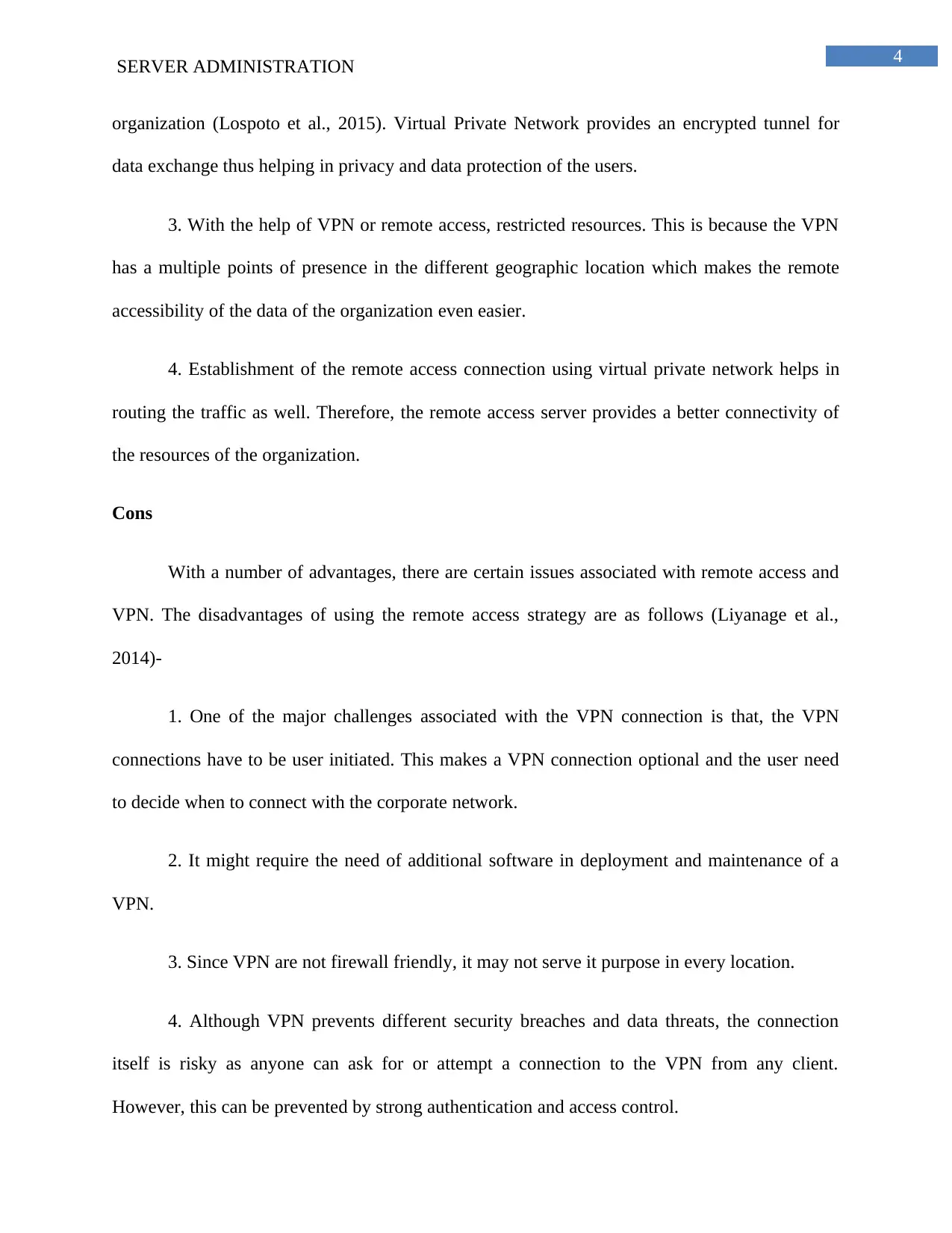
4
SERVER ADMINISTRATION
organization (Lospoto et al., 2015). Virtual Private Network provides an encrypted tunnel for
data exchange thus helping in privacy and data protection of the users.
3. With the help of VPN or remote access, restricted resources. This is because the VPN
has a multiple points of presence in the different geographic location which makes the remote
accessibility of the data of the organization even easier.
4. Establishment of the remote access connection using virtual private network helps in
routing the traffic as well. Therefore, the remote access server provides a better connectivity of
the resources of the organization.
Cons
With a number of advantages, there are certain issues associated with remote access and
VPN. The disadvantages of using the remote access strategy are as follows (Liyanage et al.,
2014)-
1. One of the major challenges associated with the VPN connection is that, the VPN
connections have to be user initiated. This makes a VPN connection optional and the user need
to decide when to connect with the corporate network.
2. It might require the need of additional software in deployment and maintenance of a
VPN.
3. Since VPN are not firewall friendly, it may not serve it purpose in every location.
4. Although VPN prevents different security breaches and data threats, the connection
itself is risky as anyone can ask for or attempt a connection to the VPN from any client.
However, this can be prevented by strong authentication and access control.
SERVER ADMINISTRATION
organization (Lospoto et al., 2015). Virtual Private Network provides an encrypted tunnel for
data exchange thus helping in privacy and data protection of the users.
3. With the help of VPN or remote access, restricted resources. This is because the VPN
has a multiple points of presence in the different geographic location which makes the remote
accessibility of the data of the organization even easier.
4. Establishment of the remote access connection using virtual private network helps in
routing the traffic as well. Therefore, the remote access server provides a better connectivity of
the resources of the organization.
Cons
With a number of advantages, there are certain issues associated with remote access and
VPN. The disadvantages of using the remote access strategy are as follows (Liyanage et al.,
2014)-
1. One of the major challenges associated with the VPN connection is that, the VPN
connections have to be user initiated. This makes a VPN connection optional and the user need
to decide when to connect with the corporate network.
2. It might require the need of additional software in deployment and maintenance of a
VPN.
3. Since VPN are not firewall friendly, it may not serve it purpose in every location.
4. Although VPN prevents different security breaches and data threats, the connection
itself is risky as anyone can ask for or attempt a connection to the VPN from any client.
However, this can be prevented by strong authentication and access control.
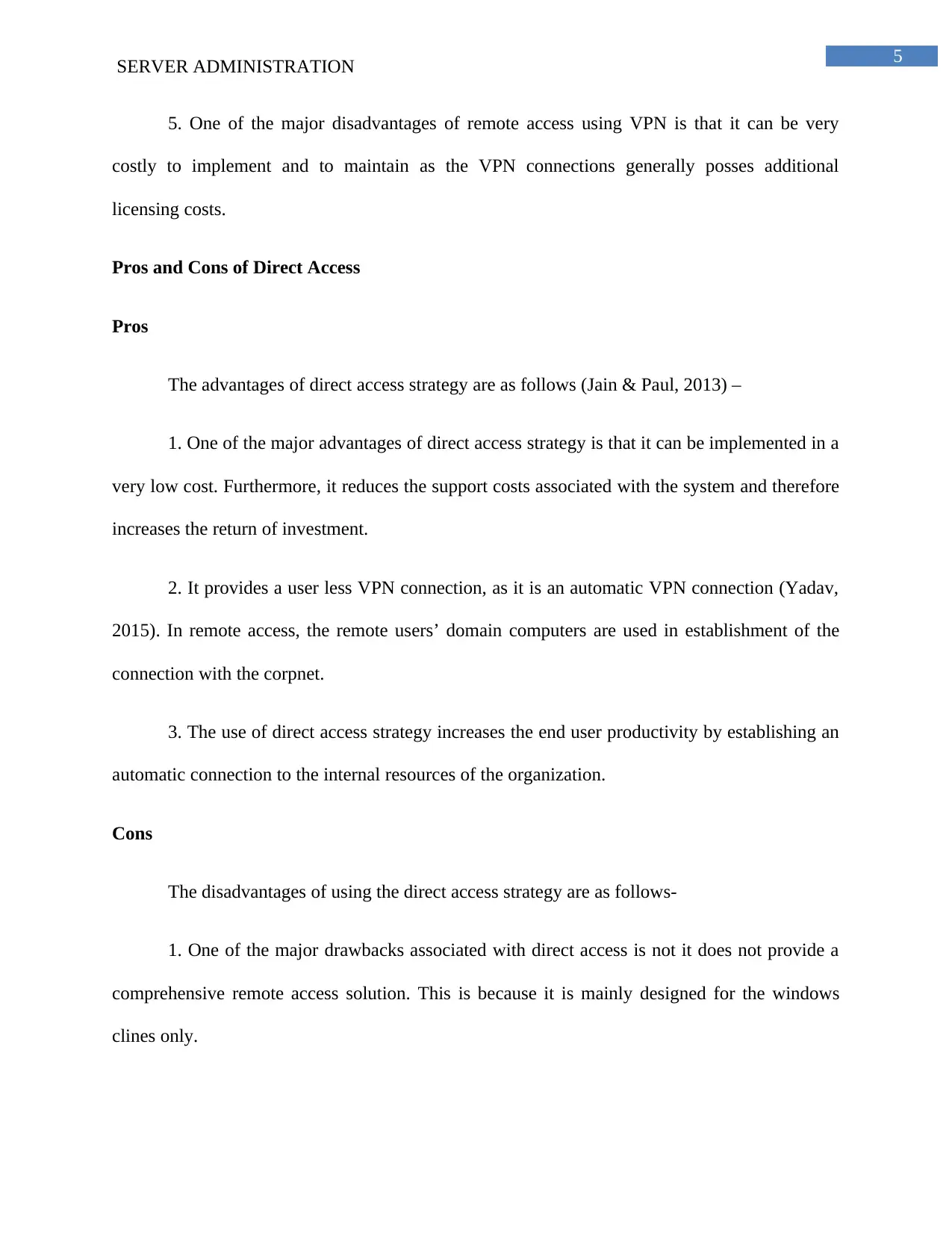
5
SERVER ADMINISTRATION
5. One of the major disadvantages of remote access using VPN is that it can be very
costly to implement and to maintain as the VPN connections generally posses additional
licensing costs.
Pros and Cons of Direct Access
Pros
The advantages of direct access strategy are as follows (Jain & Paul, 2013) –
1. One of the major advantages of direct access strategy is that it can be implemented in a
very low cost. Furthermore, it reduces the support costs associated with the system and therefore
increases the return of investment.
2. It provides a user less VPN connection, as it is an automatic VPN connection (Yadav,
2015). In remote access, the remote users’ domain computers are used in establishment of the
connection with the corpnet.
3. The use of direct access strategy increases the end user productivity by establishing an
automatic connection to the internal resources of the organization.
Cons
The disadvantages of using the direct access strategy are as follows-
1. One of the major drawbacks associated with direct access is not it does not provide a
comprehensive remote access solution. This is because it is mainly designed for the windows
clines only.
SERVER ADMINISTRATION
5. One of the major disadvantages of remote access using VPN is that it can be very
costly to implement and to maintain as the VPN connections generally posses additional
licensing costs.
Pros and Cons of Direct Access
Pros
The advantages of direct access strategy are as follows (Jain & Paul, 2013) –
1. One of the major advantages of direct access strategy is that it can be implemented in a
very low cost. Furthermore, it reduces the support costs associated with the system and therefore
increases the return of investment.
2. It provides a user less VPN connection, as it is an automatic VPN connection (Yadav,
2015). In remote access, the remote users’ domain computers are used in establishment of the
connection with the corpnet.
3. The use of direct access strategy increases the end user productivity by establishing an
automatic connection to the internal resources of the organization.
Cons
The disadvantages of using the direct access strategy are as follows-
1. One of the major drawbacks associated with direct access is not it does not provide a
comprehensive remote access solution. This is because it is mainly designed for the windows
clines only.
⊘ This is a preview!⊘
Do you want full access?
Subscribe today to unlock all pages.

Trusted by 1+ million students worldwide
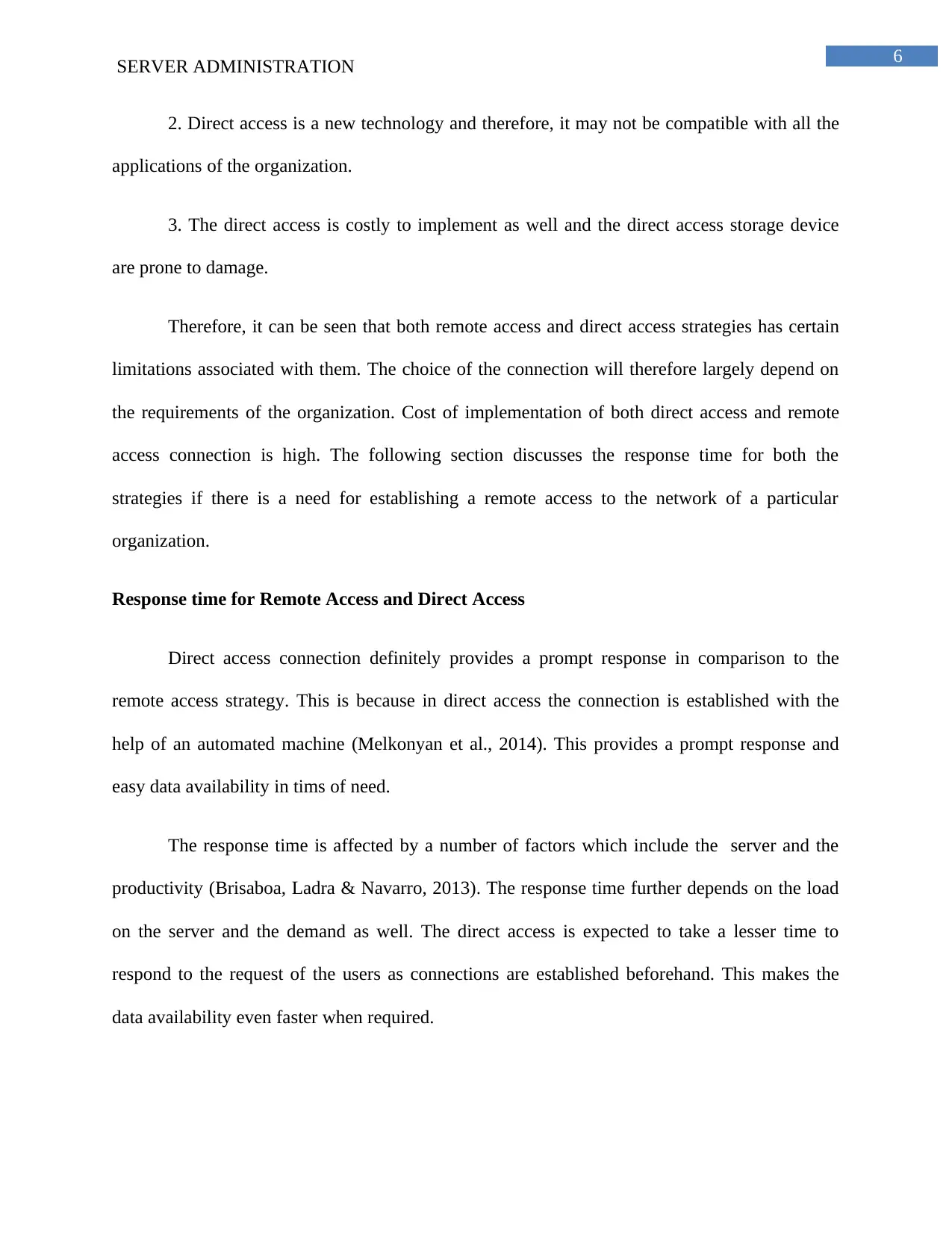
6
SERVER ADMINISTRATION
2. Direct access is a new technology and therefore, it may not be compatible with all the
applications of the organization.
3. The direct access is costly to implement as well and the direct access storage device
are prone to damage.
Therefore, it can be seen that both remote access and direct access strategies has certain
limitations associated with them. The choice of the connection will therefore largely depend on
the requirements of the organization. Cost of implementation of both direct access and remote
access connection is high. The following section discusses the response time for both the
strategies if there is a need for establishing a remote access to the network of a particular
organization.
Response time for Remote Access and Direct Access
Direct access connection definitely provides a prompt response in comparison to the
remote access strategy. This is because in direct access the connection is established with the
help of an automated machine (Melkonyan et al., 2014). This provides a prompt response and
easy data availability in tims of need.
The response time is affected by a number of factors which include the server and the
productivity (Brisaboa, Ladra & Navarro, 2013). The response time further depends on the load
on the server and the demand as well. The direct access is expected to take a lesser time to
respond to the request of the users as connections are established beforehand. This makes the
data availability even faster when required.
SERVER ADMINISTRATION
2. Direct access is a new technology and therefore, it may not be compatible with all the
applications of the organization.
3. The direct access is costly to implement as well and the direct access storage device
are prone to damage.
Therefore, it can be seen that both remote access and direct access strategies has certain
limitations associated with them. The choice of the connection will therefore largely depend on
the requirements of the organization. Cost of implementation of both direct access and remote
access connection is high. The following section discusses the response time for both the
strategies if there is a need for establishing a remote access to the network of a particular
organization.
Response time for Remote Access and Direct Access
Direct access connection definitely provides a prompt response in comparison to the
remote access strategy. This is because in direct access the connection is established with the
help of an automated machine (Melkonyan et al., 2014). This provides a prompt response and
easy data availability in tims of need.
The response time is affected by a number of factors which include the server and the
productivity (Brisaboa, Ladra & Navarro, 2013). The response time further depends on the load
on the server and the demand as well. The direct access is expected to take a lesser time to
respond to the request of the users as connections are established beforehand. This makes the
data availability even faster when required.
Paraphrase This Document
Need a fresh take? Get an instant paraphrase of this document with our AI Paraphraser
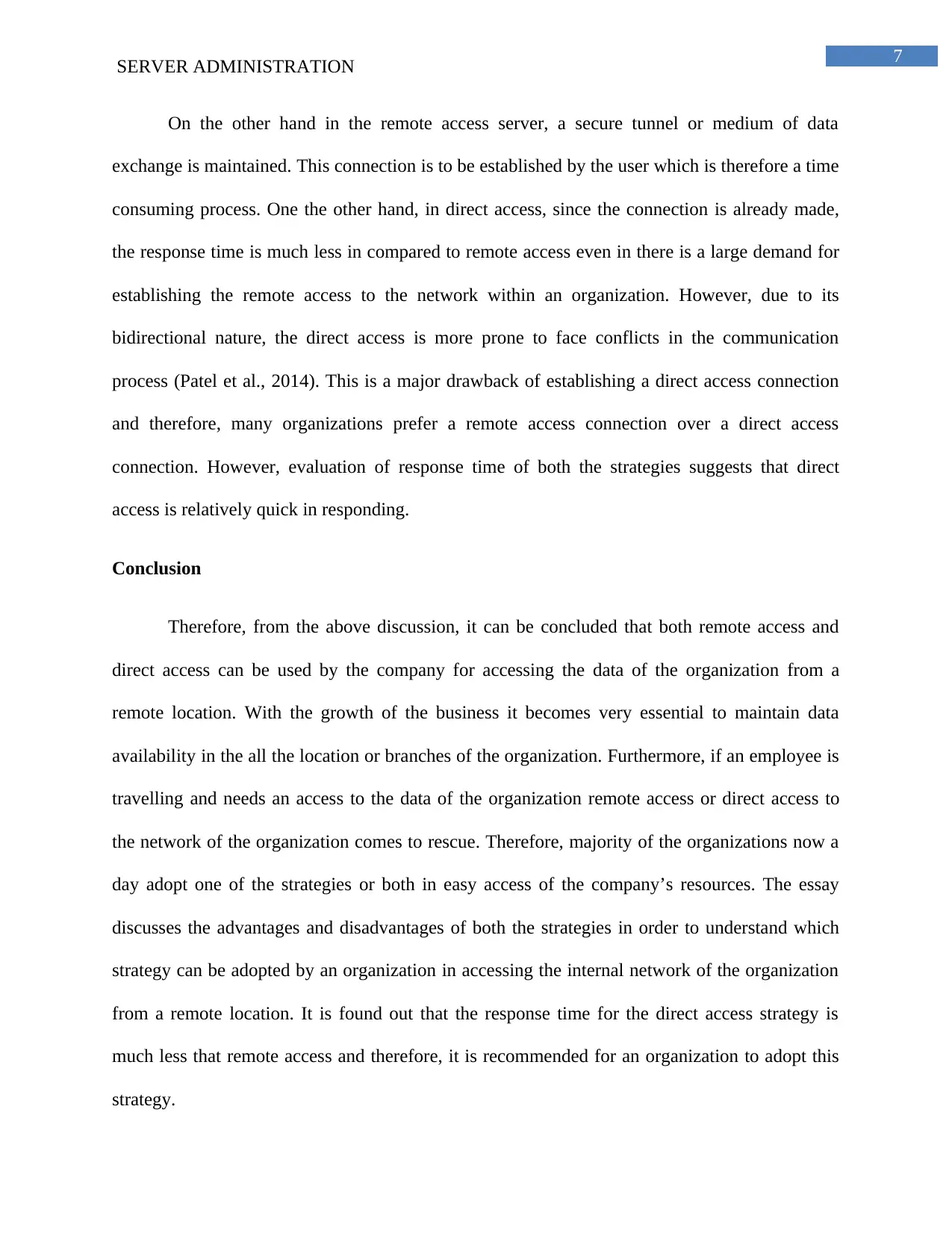
7
SERVER ADMINISTRATION
On the other hand in the remote access server, a secure tunnel or medium of data
exchange is maintained. This connection is to be established by the user which is therefore a time
consuming process. One the other hand, in direct access, since the connection is already made,
the response time is much less in compared to remote access even in there is a large demand for
establishing the remote access to the network within an organization. However, due to its
bidirectional nature, the direct access is more prone to face conflicts in the communication
process (Patel et al., 2014). This is a major drawback of establishing a direct access connection
and therefore, many organizations prefer a remote access connection over a direct access
connection. However, evaluation of response time of both the strategies suggests that direct
access is relatively quick in responding.
Conclusion
Therefore, from the above discussion, it can be concluded that both remote access and
direct access can be used by the company for accessing the data of the organization from a
remote location. With the growth of the business it becomes very essential to maintain data
availability in the all the location or branches of the organization. Furthermore, if an employee is
travelling and needs an access to the data of the organization remote access or direct access to
the network of the organization comes to rescue. Therefore, majority of the organizations now a
day adopt one of the strategies or both in easy access of the company’s resources. The essay
discusses the advantages and disadvantages of both the strategies in order to understand which
strategy can be adopted by an organization in accessing the internal network of the organization
from a remote location. It is found out that the response time for the direct access strategy is
much less that remote access and therefore, it is recommended for an organization to adopt this
strategy.
SERVER ADMINISTRATION
On the other hand in the remote access server, a secure tunnel or medium of data
exchange is maintained. This connection is to be established by the user which is therefore a time
consuming process. One the other hand, in direct access, since the connection is already made,
the response time is much less in compared to remote access even in there is a large demand for
establishing the remote access to the network within an organization. However, due to its
bidirectional nature, the direct access is more prone to face conflicts in the communication
process (Patel et al., 2014). This is a major drawback of establishing a direct access connection
and therefore, many organizations prefer a remote access connection over a direct access
connection. However, evaluation of response time of both the strategies suggests that direct
access is relatively quick in responding.
Conclusion
Therefore, from the above discussion, it can be concluded that both remote access and
direct access can be used by the company for accessing the data of the organization from a
remote location. With the growth of the business it becomes very essential to maintain data
availability in the all the location or branches of the organization. Furthermore, if an employee is
travelling and needs an access to the data of the organization remote access or direct access to
the network of the organization comes to rescue. Therefore, majority of the organizations now a
day adopt one of the strategies or both in easy access of the company’s resources. The essay
discusses the advantages and disadvantages of both the strategies in order to understand which
strategy can be adopted by an organization in accessing the internal network of the organization
from a remote location. It is found out that the response time for the direct access strategy is
much less that remote access and therefore, it is recommended for an organization to adopt this
strategy.
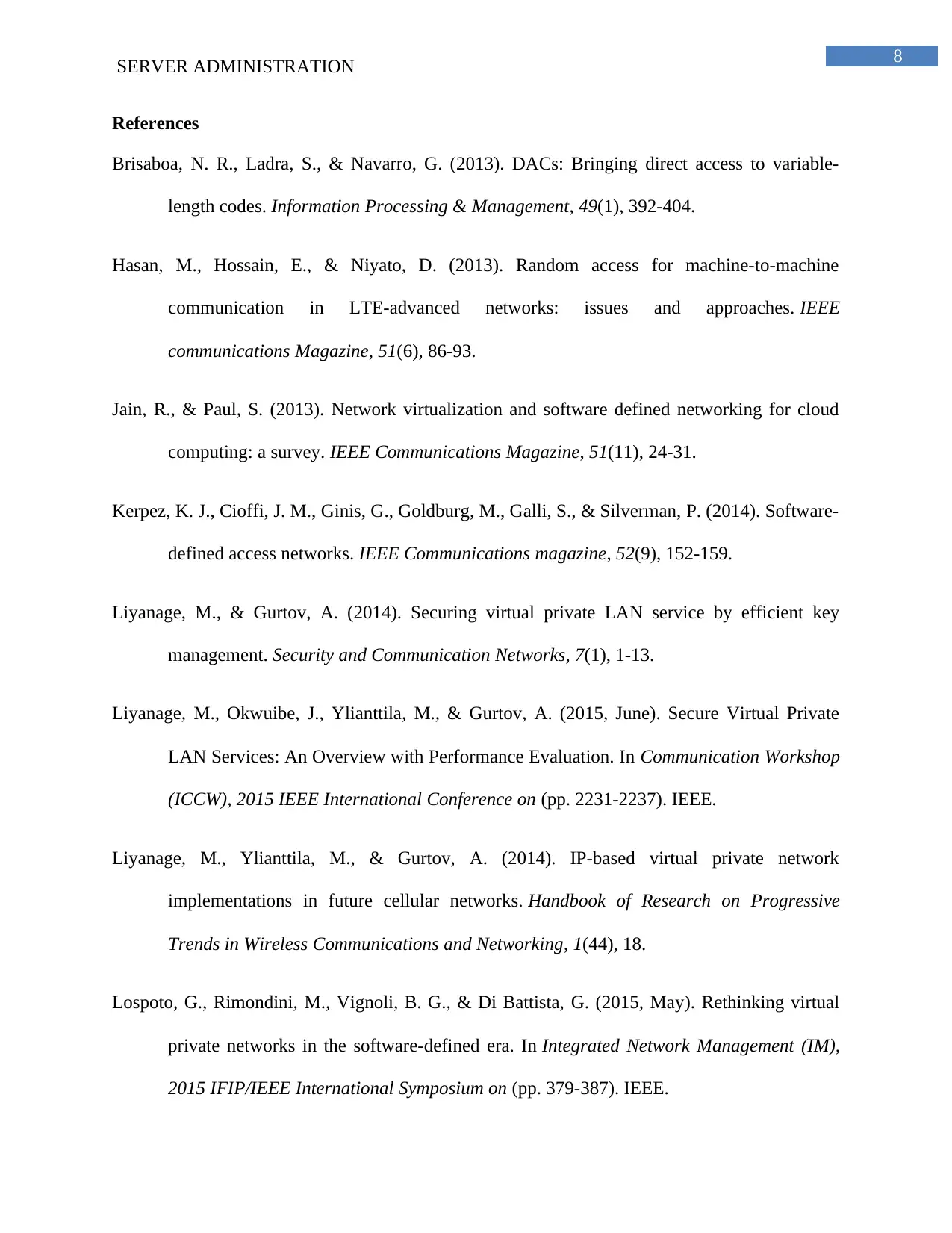
8
SERVER ADMINISTRATION
References
Brisaboa, N. R., Ladra, S., & Navarro, G. (2013). DACs: Bringing direct access to variable-
length codes. Information Processing & Management, 49(1), 392-404.
Hasan, M., Hossain, E., & Niyato, D. (2013). Random access for machine-to-machine
communication in LTE-advanced networks: issues and approaches. IEEE
communications Magazine, 51(6), 86-93.
Jain, R., & Paul, S. (2013). Network virtualization and software defined networking for cloud
computing: a survey. IEEE Communications Magazine, 51(11), 24-31.
Kerpez, K. J., Cioffi, J. M., Ginis, G., Goldburg, M., Galli, S., & Silverman, P. (2014). Software-
defined access networks. IEEE Communications magazine, 52(9), 152-159.
Liyanage, M., & Gurtov, A. (2014). Securing virtual private LAN service by efficient key
management. Security and Communication Networks, 7(1), 1-13.
Liyanage, M., Okwuibe, J., Ylianttila, M., & Gurtov, A. (2015, June). Secure Virtual Private
LAN Services: An Overview with Performance Evaluation. In Communication Workshop
(ICCW), 2015 IEEE International Conference on (pp. 2231-2237). IEEE.
Liyanage, M., Ylianttila, M., & Gurtov, A. (2014). IP-based virtual private network
implementations in future cellular networks. Handbook of Research on Progressive
Trends in Wireless Communications and Networking, 1(44), 18.
Lospoto, G., Rimondini, M., Vignoli, B. G., & Di Battista, G. (2015, May). Rethinking virtual
private networks in the software-defined era. In Integrated Network Management (IM),
2015 IFIP/IEEE International Symposium on (pp. 379-387). IEEE.
SERVER ADMINISTRATION
References
Brisaboa, N. R., Ladra, S., & Navarro, G. (2013). DACs: Bringing direct access to variable-
length codes. Information Processing & Management, 49(1), 392-404.
Hasan, M., Hossain, E., & Niyato, D. (2013). Random access for machine-to-machine
communication in LTE-advanced networks: issues and approaches. IEEE
communications Magazine, 51(6), 86-93.
Jain, R., & Paul, S. (2013). Network virtualization and software defined networking for cloud
computing: a survey. IEEE Communications Magazine, 51(11), 24-31.
Kerpez, K. J., Cioffi, J. M., Ginis, G., Goldburg, M., Galli, S., & Silverman, P. (2014). Software-
defined access networks. IEEE Communications magazine, 52(9), 152-159.
Liyanage, M., & Gurtov, A. (2014). Securing virtual private LAN service by efficient key
management. Security and Communication Networks, 7(1), 1-13.
Liyanage, M., Okwuibe, J., Ylianttila, M., & Gurtov, A. (2015, June). Secure Virtual Private
LAN Services: An Overview with Performance Evaluation. In Communication Workshop
(ICCW), 2015 IEEE International Conference on (pp. 2231-2237). IEEE.
Liyanage, M., Ylianttila, M., & Gurtov, A. (2014). IP-based virtual private network
implementations in future cellular networks. Handbook of Research on Progressive
Trends in Wireless Communications and Networking, 1(44), 18.
Lospoto, G., Rimondini, M., Vignoli, B. G., & Di Battista, G. (2015, May). Rethinking virtual
private networks in the software-defined era. In Integrated Network Management (IM),
2015 IFIP/IEEE International Symposium on (pp. 379-387). IEEE.
⊘ This is a preview!⊘
Do you want full access?
Subscribe today to unlock all pages.

Trusted by 1+ million students worldwide
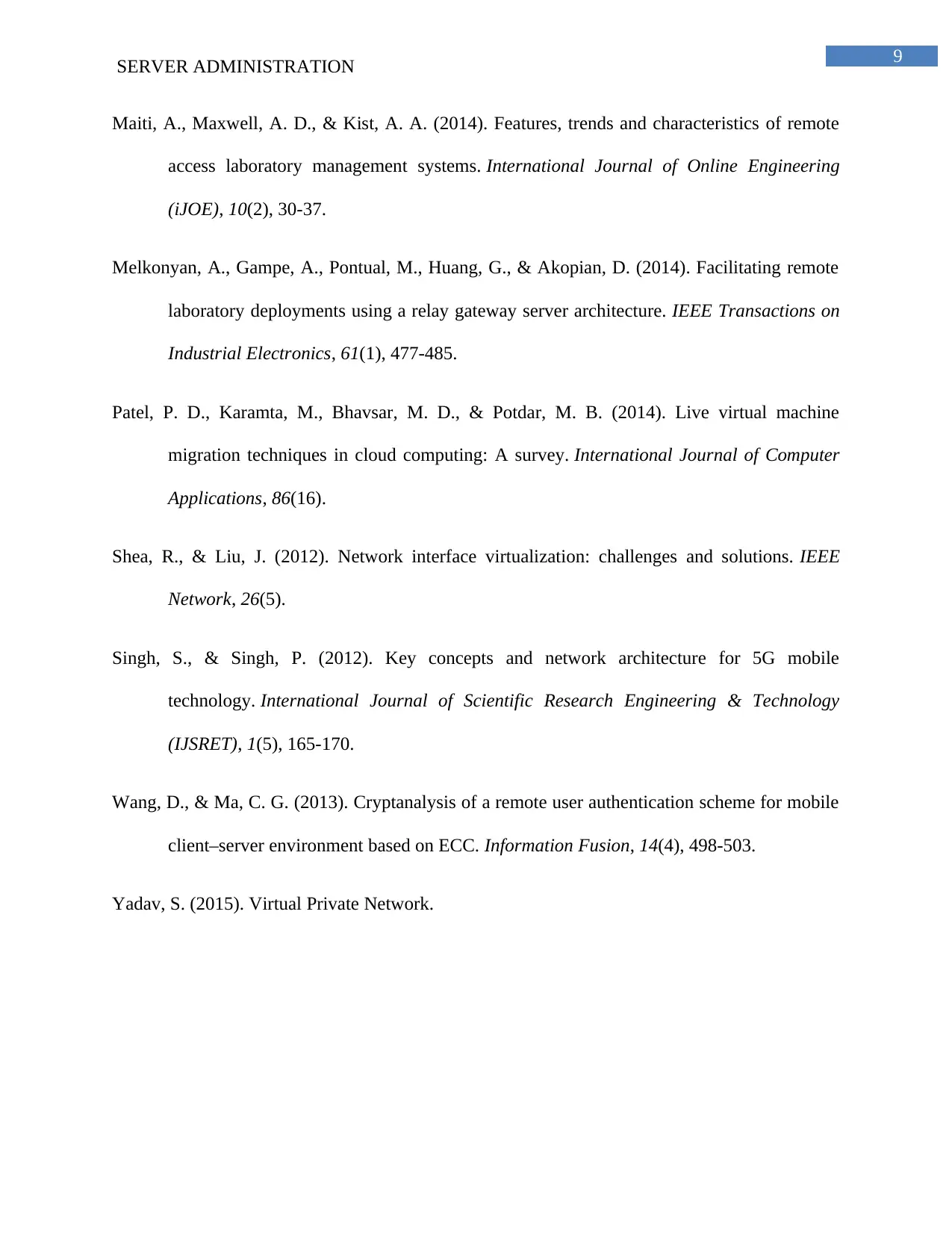
9
SERVER ADMINISTRATION
Maiti, A., Maxwell, A. D., & Kist, A. A. (2014). Features, trends and characteristics of remote
access laboratory management systems. International Journal of Online Engineering
(iJOE), 10(2), 30-37.
Melkonyan, A., Gampe, A., Pontual, M., Huang, G., & Akopian, D. (2014). Facilitating remote
laboratory deployments using a relay gateway server architecture. IEEE Transactions on
Industrial Electronics, 61(1), 477-485.
Patel, P. D., Karamta, M., Bhavsar, M. D., & Potdar, M. B. (2014). Live virtual machine
migration techniques in cloud computing: A survey. International Journal of Computer
Applications, 86(16).
Shea, R., & Liu, J. (2012). Network interface virtualization: challenges and solutions. IEEE
Network, 26(5).
Singh, S., & Singh, P. (2012). Key concepts and network architecture for 5G mobile
technology. International Journal of Scientific Research Engineering & Technology
(IJSRET), 1(5), 165-170.
Wang, D., & Ma, C. G. (2013). Cryptanalysis of a remote user authentication scheme for mobile
client–server environment based on ECC. Information Fusion, 14(4), 498-503.
Yadav, S. (2015). Virtual Private Network.
SERVER ADMINISTRATION
Maiti, A., Maxwell, A. D., & Kist, A. A. (2014). Features, trends and characteristics of remote
access laboratory management systems. International Journal of Online Engineering
(iJOE), 10(2), 30-37.
Melkonyan, A., Gampe, A., Pontual, M., Huang, G., & Akopian, D. (2014). Facilitating remote
laboratory deployments using a relay gateway server architecture. IEEE Transactions on
Industrial Electronics, 61(1), 477-485.
Patel, P. D., Karamta, M., Bhavsar, M. D., & Potdar, M. B. (2014). Live virtual machine
migration techniques in cloud computing: A survey. International Journal of Computer
Applications, 86(16).
Shea, R., & Liu, J. (2012). Network interface virtualization: challenges and solutions. IEEE
Network, 26(5).
Singh, S., & Singh, P. (2012). Key concepts and network architecture for 5G mobile
technology. International Journal of Scientific Research Engineering & Technology
(IJSRET), 1(5), 165-170.
Wang, D., & Ma, C. G. (2013). Cryptanalysis of a remote user authentication scheme for mobile
client–server environment based on ECC. Information Fusion, 14(4), 498-503.
Yadav, S. (2015). Virtual Private Network.
1 out of 10
Related Documents
Your All-in-One AI-Powered Toolkit for Academic Success.
+13062052269
info@desklib.com
Available 24*7 on WhatsApp / Email
![[object Object]](/_next/static/media/star-bottom.7253800d.svg)
Unlock your academic potential
Copyright © 2020–2025 A2Z Services. All Rights Reserved. Developed and managed by ZUCOL.




